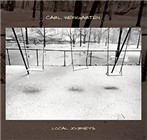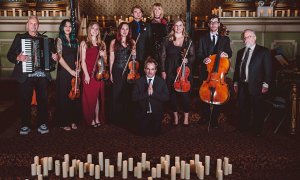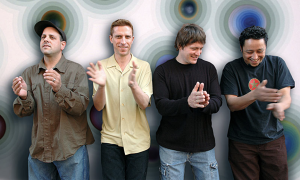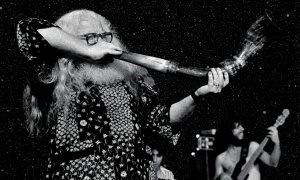Home » Jazz Articles » From the Inside Out » Blue Note and Recording Master Re-Present RVG's Heritage
Blue Note and Recording Master Re-Present RVG's Heritage
Working with such legendary entrepreneurs / producers as Alfred Lion (Blue Note), Creed Taylor (Verve, A&M, CTI) and Bob Weinstock (Prestige), Rudy Van Gelder served as recording engineer for some of the greatest jazz records ever made. His work is as respected as that of any instrumentalist, composer, singer, arranger or producer in jazz.
Think of great jazz records as building the foundation for modern jazz brick by brick: Rudy Van Gelder is the mortar that binds most great jazz records together.
Decades of such scientific advances as 24-bit digital technology now give Van Gelder the chance to revisit and create many of these recordings again. Blue Note has launched an entire "Rudy Van Gelder (RVG) series of titles, reissued after contemporary remastering by this master engineer.
Perfect Takes, a "best of the best of Blue Note compilation selected by RVG, includes on its companion DVD an interview with Van Gelder conducted by Michael Cuscuna, who helped co-found the respected reissue label Mosaic Records, helped construct the Impulse! Records reissue series for GRP Records, and who worked for Blue Note from the mid-1970s into the early '80s and continues to oversee Blue Note's acclaimed, ongoing reissue series.
Van Gelder reflects upon many things in carefully considered responses during this interview, including how it all began.
"What happened was, I started recording my friends: A trumpet player, a clarinetist, a pianist, and doing sessions in my parents' house, he recalls. "That soon grew, and after a while I started to hear from people in the neighborhood, could I record them? After a while the phone started to ring, and that grew, that area (recording for other people), and that's how it started.
"There was a period when I was recording for both Alfred Lion of Blue Note and Bob Weinstock of Prestige, he later reflects. "The differences in working with the two of them were, for me, quite large.
"For example, if I had a new microphone I wanted to try out: Alfred was the sort of person who was very much organized; he knew what he wanted, he knew what the finished product would be while he was doing the session. It was pretty intense working for him because he knew what he wanted and I had to deliver what he wanted, and that's what I was doing. On the other hand, the Prestige sessions were a lot looser, from the musicians' point they were a little freer, there weren't a lot of preparations, they sort of decided things as they went along. So I would always experiment with the technical stuff for Prestige, make sure I understood it, make sure I knew what it did, make sure I knew how it worked, and then I would use that for Blue Note.
When Cuscuna raises to Van Gelder this opportunity "to remaster, given today's technology, his original recordings (a project that Cuscuna at first believed RVG would not accept), Van Gelder allows, "When you first called me, I thought, 'Wow. That's the best job I ever had.' The idea of listening to the old tapes that I made, and the chance to transfer them -since the advent of the CD, people have been doing that. This is my opportunity to present my version of how those things should sound. What a great job this is!
"The remastering series has enabled me to get closer to the music of many musicians who played here and in Hackensack, much closer than I ever could before. People like Hank Mobley, people like Lee Morgan, who I never...I wish I could record him again, I could do a much better job. People like that. I got much closer to their music than I ever did just by talking to them at the session. I had a different responsibility at that time. I was in another world. I was not listening to the music...I was trying to make these individual people be heard in the way that they wanted to be heard. That's what I was doing on the date.
"Now all that is over with, here's the way the music sounded, and it's like a first time experience for me, he concludes. "And not just on one album -on a whole bunch of albums! It was great fun!
 Art Blakey & The Jazz Messengers
Art Blakey & The Jazz Messengers A Night in Tunisia
(Blue Note 1960 -RVG Edition)
Art Blakey, drums; Lee Morgan, trumpet; Wayne Shorter, tenor sax; Bobby Timmons, piano; Jymie Merritt, bass.
Except for the classic Dizzy Gillespie title track, this set from one of the great jazz finishing schools was composed entirely by young lions Morgan and Shorter, one of the best frontlines in the history of bebop quintets, and Timmons. Reissue annotator Bob Blumenthal suggests that its title track is "one of the greatest versions of 'A Night in Tunisia' ever recorded.
If Blumenthal misspeaks, it's not by much. It certainly boasts one of the greatest OPENINGS to "Tunisia ever recorded: From the primordial swirl of Blakey's drums—intense and primal -emerge piano chords that slowly bring the horizon into view. Then the familiar concert of horns trumpets the emergence of civilization on the horizon, majestically becoming more visible through the mist.
Van Gelder remasters a great RECORDING too, so transparent and bright that you can hear Blakey's gruff vocal encouragement to Morgan in the trumpeter's unaccompanied closing blasts.
Normally more associated with muscle, it's the power AND precision of Blakey's drum rolls that animate "Koko's Waltz and "Sincerely Diana, a rollicking Morgan turn underwired with a walking bass line. The leader "gives the drummer some in the midst of "Sincerely and when he thumps that beat, brother, it stays thumped!
Timmons' solo in his composition "So Tired is anything but that: Free-flowing with touches of Latin dancehalls, blues joints, country churches and cool spacious funk a la Ahmad Jamal or Ramsey Lewis.
 Sonny Clark
Sonny Clark Dial "S for Sonny
(Blue Note 1958 -RVG Edition)
Sonny Clark, piano; Art Farmer, trumpet; Curtis Fuller, trombone; Hank Mobley, tenor sax; Wilbur Ware, bass; Louis Hayes, drums.
Before making this first album as a leader, pianist Clark served among the leading proponents of "West Coast Jazz, the Lighthouse All-Stars, and supported groups led by Dinah Washington and Charles Mingus.
Farmer, Fuller and Mobley are soulful soloists who keep dishing out bucketsful of funk. This trio sounds intent on cutting each other, especially Farmer and Morgan, in the friendly yet furious jam "Bootin' It. Like Dr. J. in his 1970s prime levitating for a swoop dunk, the ensemble glides elegant and funky through "Sonny's Mood. Here Farmer plays as well as just about any other trumpet player recording in '58 -cool and blue like you know who, yet shiny and brassy too.
"Shoutin' on a Riff proves expertly titled as the horn ensemble, then each rotating soloist in the quicksilver melodic breaks, all jump out of the beat as if blasted from a cannon. Clark spins out his solo like fine yarn, weaving an impressive mosaic of ideas that's not quite Erroll Garner or Art Tatum but certainly worthy of their lineage.
Leading Ware and Hayes through a sophisticated trio reading of the Gershwin's "Love Walked In reveals the leader's own style: A light touch, with the playful but not frivolous sense of Vince Guaraldi and just a hint of Horace Silver's "Latin tinge in the rhythm and harmony.
"S was one of Blue Note's first stereo recording sessions.
 Grant Green
Grant Green Feelin' the Spirit
(Blue Note 1963 -RVG Edition)
Grant Green, guitar; Herbie Hancock, piano; Butch Warren, bass; Billy Higgins, drums; Garvin Masseaux, tambourine.
The original liner notes describe this set as "the only instance (I know) of a group of modern jazzmen performing a program made up exclusively of spirituals...the result is a fascinating combination: the techniques of modern jazz, blues, and gospel, all applied to the spiritual. Benefiting from decades of hindsight, Blumenthal notes that Green had previously released albums dedicated to Latin and country-western themes.
Pianist Hancock steals this show with some of the most down-home gutbucket funky accompaniment he ever played: With joyously blue and soulful exclamations to counterpoint the leader's elegant guitar runs in the stately "Joshua Fought the Battle of Jericho, with beat-stomping boogie in "Just a Closer Walk With Thee, and, with Warren, rocking "Go Down Moses with a Latin beat.
Green glides through each tune as if he was half angel and half Wes Montgomery -changing just the right note in just the right way with a flat here or a sharp there, mixing colors as if finger painting -turning spirituals into jazz. He rolls in his hands the chords in "Jericho like a jeweler examining rubies and emeralds, their sound dark and sparkling, and unravels crisp flurries of bright notes in "Closer Walk like unpacking strings of holiday lights.
As a band, they rock "Nobody Knows The Trouble I've Seen as half-gospel, half-blues, Green and Hancock testifying softly at first then more strident as the drummer and bassist walk and whisper with the beat.
 Herbie Hancock
Herbie Hancock Speak Like a Child
(Blue Note 1968 -RVG Edition)
Herbie Hancock, piano; Thad Jones, flugelhorn; Peter Phillips, bass trombone; Jerry Dodgion, alto flute; Ron Carter, bass; Mickey Roker, drums.
Hancock's unusual horn instrumentation gives Speak a unique voice among his work. For the original liner notes, he relates this album to his previous Blue Note release (the classic Maiden Voyage) for annotator Nat Hentoff: "There is a type of music in between jazz and rock. It has elements of both but retains and builds on its own identity. Its jazz elements include improvisation and it's like rock in that it emphasizes particular rhythmic patterns to work off of.
Hancock had by this time been a member of Miles Davis' second great quintet for about five years. From this set, "Riot was originally recorded by Davis for his 1967 album Nefertiti, and Hancock composed "The Sorcerer for the title track of another album Davis released in 1967.
Except for Carter's "First Trip, Speak is composed entirely by Hancock. Through these compositions and his playing (he is the only soloist), Hancock reveals a depth of intelligence and feeling (NOT sentimentality) that makes it easy to understand how someone who previously employed McCoy Tyner as pianist, like Davis, would be attracted to Hancock's work. Its title track is a ballad of soft, mesmerizing beauty; another great Davis pianist, Bill Evans, is a point of reference for his playing, but the song itself is a rare, gentle type of gorgeous.
The sunny "First Trip is not so much a melody as a framework, jungle gym monkey bars for Hancock and his playmates to climb, with Hancock scrambling through a torrent of ideas, including some Ramsey Lewis boogie and blues.
Len Lyons included Speak Like a Child in his study "The 100 Greatest Jazz Albums of All Time, published in 1980. He referred its instrumentation back to Gil Evans' work with Davis and others, and concluded, "Herbie's arrangements here qualify as some of the most original brass-band music in jazz -far from the blaring idiom one normally associates with the word 'brass.'
 Hank Mobley
Hank Mobley Hi Voltage
(Blue Note 1968 -RVG Edition)
Hank Mobley, tenor sax; Blue Mitchell, trumpet; Jackie McLean, alto sax; John Hicks, piano; Bob Cranshaw, bass; Billy Higgins, drums.
Mobley is best-known as a mainstream soul-jazz tenor -the original liner notes by venerated jazz entrepreneur Leonard Feather pin down his sound in between the fat heavy tenor sound of Gene Ammons and the feathery sound of Stan Getz -thanks to recordings such as this.
Completely composed by the leader, it is a Hi Voltage old-school soul-jazz throwdown between Mobley and McLean with Mitchell in between. Saxophonists Mobley and McLean rock the title track, a 24-bar blues that seems to trumpet its kinship to Lee Morgan's classic "The Sidewinder by giving Mitchell the opening and closing solo choruses, while pianist Hicks rocks the house with Ray Charles' gospel boogie style. "Two and One delivers similarly well-cooked goods, while the angular bop of "Advance Notion is fueled by Mobley's pronounced sense of swing and Hicks' opening up the throttle to full-tilt boogie.
Mobley offers two changes of pace: He dusts "Bossa De Luxe in soft pastels of Brazilian-flavored rhythmic and harmonic movement, and introduces "No More Goodbys with romantic playing both gut-level and pretty, lifting the veil off this after-hours ballad, a necessary slow number because your dancin' ass just can't boogie no more.
 Wayne Shorter
Wayne Shorter Night Dreamer
(Blue Note 1964 -RVG Edition)
Wayne Shorter, tenor sax; Lee Morgan, trumpet; McCoy Tyner, piano; Reggie Workman, bass; Elvin Jones, drums.
"This date came at a time when I was entering a new stage as a writer, Shorter told Nat Hentoff for this set's original liner notes. The tunes, all composed by Shorter, showcase a tenor player well versed in tradition but who employs advanced technique in an adventurous spirit to stretch the boundaries of the tradition.
Though known more as a firebrand from his incendiary work in the same Davis quintet as Hancock, in Shorter's more temperate moments on Dreamer, such as his intro to "Virgo (where he and pianist Tyner liquidly sound on the cusp of melting into "The Way You Look Tonight ), you really hear the tenor tradition from Ben Webster and others come through.
Three of the 1960s finest jazz soloists on this one session, Shorter, Tyner and Morgan blend their voices here to create THE jazz sound of that decade. Tyner is typically strong yet tender in "Charcoal Blues and "Armageddon, proving the legitimacy of his nickname "the gentle giant. In "Oriental Folk Song and the title track, Morgan swings and bops like he's got full pockets on a Saturday night!
The sharp and toothsome "Black Nile demonstrates the best of the music of its age: Shorter's high-energy opening solo is propelled in time by Tyner's chords and Jones' bass drum "bombs dropped in tandem with bassist Workman. Seemingly inspired by the leader, Tyner and Morgan swap scalding solo turns, then Jones whips the ensemble to the finish line.
"Charcoal Blues and "Armageddon prove that structure is important to both Shorter the composer and the soloist, studiously turning their melodies over and inside and out through his saxophone as if examining the facets of a precious gemstone in the light.
 Various Artists
Various Artists Blue Note Perfect Takes
(Blue Note -RVG Edition)
Van Gelder annotates his own remastered collection and describes Perfect Takes as "a compilation of my favorite tracks from the RVG series.
"I wish I could record some of these musicians again with the equipment I have now, he continues. "But just being able to hear these great artists again in their prime makes me feel that recording jazz in New Jersey sure beat anything else that was going on in the world during that time.
What's not to like in this set of pristine jazz classics? This Perfect collection includes:
The wonderfully oddball in melody and rhythm "Four in One, where it sounds like Thelonious Monk not only plays the "wrong notes but plays them in the "wrong places, and the sound of Milt Jackson's vibes playing tag with Monk's piano, both pursued by Art Blakey's drums, is pure joy.
"Budo from Miles Davis' seminal Birth of the Cool session, the historic nonet date featuring Kai Winding, Gerry Mulligan, Lee Konitz and Max Roach, where Davis jabs and wallops fleet and powerful like Sugar Ray Robinson.
Donald Byrd's treatment of "Christo Redentor, a rare display of voices on a Blue Note session, moaning soft and low counterpoint to dark blues piano from Hancock and blues trumpet from the leader.
Van Gelder ends Perfect with Jimmy Smith's funky Hammond B-3 update of Ma Rainey's "See See Rider, smooth and mellow, chilled with icy-hot runs from guitarist Kenny Burrell, two Percy France saxophone breaks floating like cocktail cherries in the thick groove, and with Smith peeling off long fat greasy runs like pulling out one French fry from a stack smothered in a mess of cheese and gravy.
"Jimmy Smith's 'See See Rider' comes from one of the last Blue Note sessions done at the studio in my parents' living room in Hackensack, Van Gelder notes in closing this set.
Related Articles
Rudy Van Gelder Interview
Blue Note's Golden Decade
Tags
PREVIOUS / NEXT
Support All About Jazz
 All About Jazz has been a pillar of jazz since 1995, championing it as an art form and, more importantly, supporting the musicians who make it. Our enduring commitment has made "AAJ" one of the most culturally important websites of its kind, read by hundreds of thousands of fans, musicians and industry figures every month.
All About Jazz has been a pillar of jazz since 1995, championing it as an art form and, more importantly, supporting the musicians who make it. Our enduring commitment has made "AAJ" one of the most culturally important websites of its kind, read by hundreds of thousands of fans, musicians and industry figures every month.




















